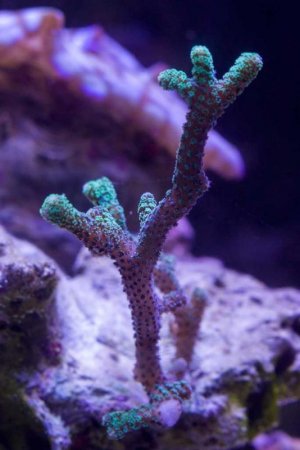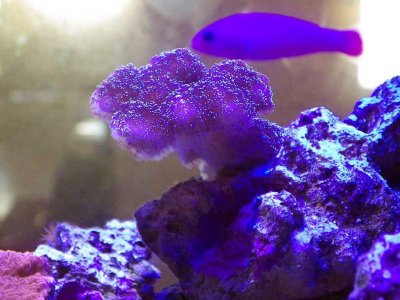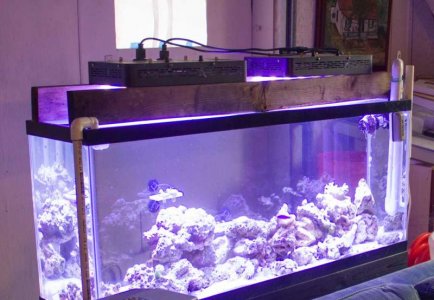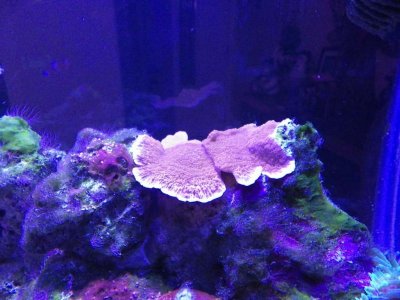I don't know what to do I've tried somethings and my coral is not growing and all have a considerable amount of color loss. I just lost my purple montipora. Red monti has no white growth rim and is not as red as it used to be. Same with my green montiporta.
A month ago (3/18/16) I got some new corals from a LFS and within two weeks the blue acro I bought started to RTN. A couple weeks later they all started to loose color. The coral I already had has lost color over the years (I have pic examples) and I've been trying to figure that out.
Nitrate 0
Ca 390
Alk 157ppm (8.792 dKH - 3.141meq/l)
Mg 1410
Lights: 2x 165W Full Spectrum LED Whites at 50% blues 60% 5" off the surface of the water. They are supported by 2x4s and they block some of the light. There is also some hinged glass lids over the tank. The hinge is black plastic right in the center of the tank also blocking light.
Flow: Hydor Koralia 750/850, and two 530GPH power heads at opposite ends of the tank.
Polyp exstention is good on my Stylophora and other montiporas but not my red acro & Superman Monti.
The Superman Monti has lost a ton of color you almost think its dead but you can still see a few orange polyps.
My Duncans open all night and sometimes during the day
Purple tipped frog spawn and Green hammer coral open during the day not sure how to say how much but they are open.
The first two photos are my stylophora in Oct of 2014 and then now obviously its grown since but lost lots of color the tips of the polyps aren't blue anymore. Most of that growing was done up until Nov 2015 I haven't noticed any growth since.
The birdsnest I just got on 03/18/16. Photo taken on 3/20/16 the second photo of it was taken today 4/15/16
How do I get my corals color back and get them to start growing? I'm really worried.
A month ago (3/18/16) I got some new corals from a LFS and within two weeks the blue acro I bought started to RTN. A couple weeks later they all started to loose color. The coral I already had has lost color over the years (I have pic examples) and I've been trying to figure that out.
Nitrate 0
Ca 390
Alk 157ppm (8.792 dKH - 3.141meq/l)
Mg 1410
Lights: 2x 165W Full Spectrum LED Whites at 50% blues 60% 5" off the surface of the water. They are supported by 2x4s and they block some of the light. There is also some hinged glass lids over the tank. The hinge is black plastic right in the center of the tank also blocking light.
Flow: Hydor Koralia 750/850, and two 530GPH power heads at opposite ends of the tank.
Polyp exstention is good on my Stylophora and other montiporas but not my red acro & Superman Monti.
The Superman Monti has lost a ton of color you almost think its dead but you can still see a few orange polyps.
My Duncans open all night and sometimes during the day
Purple tipped frog spawn and Green hammer coral open during the day not sure how to say how much but they are open.
The first two photos are my stylophora in Oct of 2014 and then now obviously its grown since but lost lots of color the tips of the polyps aren't blue anymore. Most of that growing was done up until Nov 2015 I haven't noticed any growth since.
The birdsnest I just got on 03/18/16. Photo taken on 3/20/16 the second photo of it was taken today 4/15/16
How do I get my corals color back and get them to start growing? I'm really worried.






